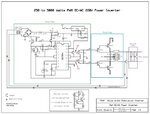Joeadeoye
Junior Member level 2

Hello engineers, I am I newbie, want to make an inverter. I am following the tutorial at https://www.instructables.com/id/250-to-5000-watts-PWM-DCAC-220V-Power-Inverter/
I was able to setup the driver stage successfully, but I am having problem with the power stage of the schematic. I used 4 Ń-channel mosfet MT3205 connected parallel, i.e. two on both sides from the driver stage.
The problem I'm having with my circuit is that, the moment I connect the battery terminal to start the inverter, the wire I use to connect the source of all the mosfet to the negative terminal of the battery will burn immediately.
When I noticed this, I increased the thickness of the wire and retest again, and now, immediately I connect the battery to start the inverter, the mosfet will get overheated immediately and get burnt instantly.
All mosfet are mounted on a large heat sink and I don't know what is causing this. Please I need help. I have burnt 6 mosfets, I can't afford to burn more...... Help
Note: I am using 12v 100Ah battery to test. My transformer is 12-0-12 primary and 220v secondary
I was able to setup the driver stage successfully, but I am having problem with the power stage of the schematic. I used 4 Ń-channel mosfet MT3205 connected parallel, i.e. two on both sides from the driver stage.
The problem I'm having with my circuit is that, the moment I connect the battery terminal to start the inverter, the wire I use to connect the source of all the mosfet to the negative terminal of the battery will burn immediately.
When I noticed this, I increased the thickness of the wire and retest again, and now, immediately I connect the battery to start the inverter, the mosfet will get overheated immediately and get burnt instantly.
All mosfet are mounted on a large heat sink and I don't know what is causing this. Please I need help. I have burnt 6 mosfets, I can't afford to burn more...... Help
Note: I am using 12v 100Ah battery to test. My transformer is 12-0-12 primary and 220v secondary


